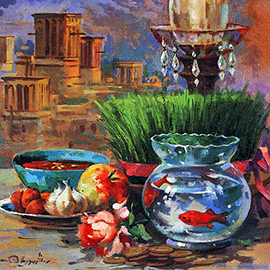
All about Iranian new year
| Tours 2020-03-14 08:41:06
Nowruz (Persian: نوروز, IPA: [nouˈɾuːz], meaning "[The] New Day") is the name of the Persian/Iranian New Year.
Nowruz
Nowruz marks the first day of spring or Equinox as and the beginning of the year in the Persian calendar. It is celebrated on the day of the astronomical Northward equinox, which usually occurs on March 21 or the previous/following day depending on where it is observed.

History of Nowruz
The celebration has its roots in Ancient Iran. Due to its antiquity, there exist various foundation myths for Nowruz in Iranian mythology. In the Zoroastrian tradition, the seven most important Zoroastrian festivals are the Gahambars and Nowruz, which occurs at the spring equinox. According to Mary Boyce,
“It seems a reasonable surmise that Nowruz, the holiest of them all, with deep doctrinal significance, was founded by Zoroaster himself.

Nowruz around the world
Nowruz is celebrated in Greater Iran, Caucasus, Central Asia and by Iranians worldwide. It is a public holiday in Iran, Iraq,Georgia, Afghanistan,Azerbaijan,Tajikistan,Turkmenistan, Uzbekistan,Kyrgyzstan, Pakistan and India.

Nowruz in the Zoroastrian faith
Zoroastrians worldwide celebrate Nowruz as the first day of the New Year. Parsi Zoroastrians of South Asian origin celebrate it as "Nowroj", "Navroz", or "Navroj" on the fixed day of March 21, while Zoroastrians of Iranian background generally celebrate, like other Iranians, on the actual Spring Equinox date.
No-Rooz, The Iranian New Year at Present Times
No-Rooz, in word, means "New Day". It is the new day that starts the year, traditionally the exact astronomical beginning of the Spring. Iranians take that as the beginning of the year. This exact second is called "Saal Tahvil".

Haft-Sin
Haft Seen, otherwise known as Haft Sīn (Persian: هفتسین) or the seven 'S's is a traditional table setting of Nowruz, the traditional Iranian spring celebration. The haft seen table includes seven items all starting with the letter sīn (س) in the Perso-Arabic alphabet
Here are you can see some of the most common of them, that are usen and their symbol of them:
somaq (a bright red spice made from crushed berries): sunrise and the spice of life
sonbol (hyacinth) : spring
sekeh (coins ) : prosperity
senjed(the sweet dry fruit of the lotus tree): love
seeb (apples ): health and beauty
samanu (a sweet pudding made from wheat): the sweetness of life
sabzeh (sprouted wheat grass): rebirth and the renewal of nature
Serkeh( Vinegar): for the patience and wisdom that comes with aging
Some other symbolic objects are placed on the table, depending on the traditions of each family. These include a goldfish, painted eggs, candles and a mirror.
